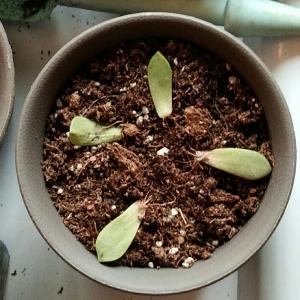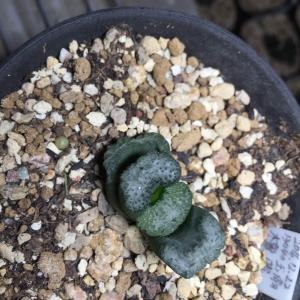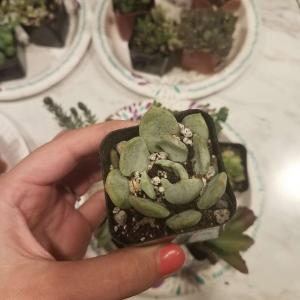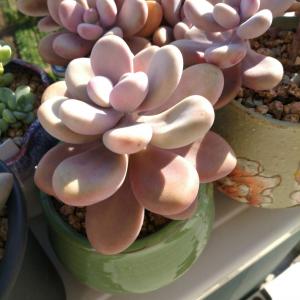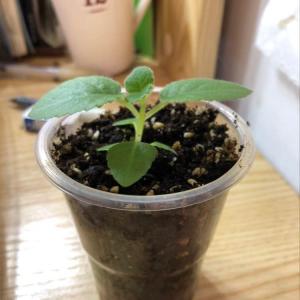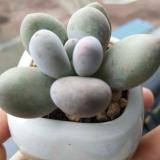文章
Dummer. ゛☀
2017年10月02日

The Agave lechuguilla (Lechuguilla) is the smallest Agave growing in the Trans-Pecos area of the Chihuahuan Desert. Its leaves are usually less than an inch wide and the plant ranges from 12 to 18 inches in height. Though sometimes listed as an indicator species of the Chihuahuan, that is not strictly the case, as this plant can also be found in the Sonoran and Coahuilan deserts as well. It is the dominant plant species on over 38,000 square miles of calcareous soils that are of little use for anything else.

Lechuguilla frequently grows in almost impenetrable thickets, and its stiff, inwardly curved spines are capable of piercing skin, leather, and even off-road vehicle tires. If you’ve ever stepped in one you understand first-hand how the curvature of the spine helps it dig deep into your calf; how its backwardly aimed side spines make it difficult to get free, and how its deep puncture wounds hurt like the dickens and can take months to heal. These spines can cripple a horse and severely injure any human who happens to fall upon it. If there is one plant in the Chihuahuan desert to avoid, this is it.
But Lechuguilla is not all bad. Like its other Agave brethren, it stays green year round. When it’s old enough it sends up a flower stalk that rises 10 to 15 feet; it is covered with lovely wine and yellow colored flowers.
Since the flowering stalk is so tall, you may spend quite a bit of time visiting the Chihuahuan Desert without seeing the small flowers which create this display.
Lechuguilla, as much as any other plant in the Trans Pecos, gives our area the look that tells us this is home. When it is in bloom Lechuguilla hosts countless pollinating insects, including the Cohuila Giant Skipper that is entirely dependent on this plant. After flowering, the remaining stalk is one of the few viable alternatives to wood to be found in the Chihuahuan desert.

Lechuguilla has been used for food, drink, and fiber for over 10,000 years. The toxic juices have been used as an arrow poison, a fish stupefier, a medicine, and a soap. Aztecs made a powerful antibiotic from a mixture of Lechuguilla juice and salt and used it as a dressing for wounds and a balm for skin infections. The Mescalero Apaches baked the central stems in pits and then rolled out the pulp, dried it and stored it as a sort of sweat bread. They also fermented the pulp to make an alcoholic drink that is made today and sold in Mexico as “Clandestino”. The water stored in the leaves is rich in salts and minerals and is sold as a sports drink.

People have always valued lechuguilla for its fiber. Its leaves are so thick with fiber that it is difficult to see how the plant stores anything else inside. The fibers are long, tough, resilient, strong, and extremely durable. Native Americans fashioned lechuguilla fibers into sandals, baskets, nets, rugs, cordage and a wide range of other products. Lechuguilla sandals have been recovered from numerous rock shelters in the eastern Trans-Pecos.

Lechuguilla frequently grows in almost impenetrable thickets, and its stiff, inwardly curved spines are capable of piercing skin, leather, and even off-road vehicle tires. If you’ve ever stepped in one you understand first-hand how the curvature of the spine helps it dig deep into your calf; how its backwardly aimed side spines make it difficult to get free, and how its deep puncture wounds hurt like the dickens and can take months to heal. These spines can cripple a horse and severely injure any human who happens to fall upon it. If there is one plant in the Chihuahuan desert to avoid, this is it.
But Lechuguilla is not all bad. Like its other Agave brethren, it stays green year round. When it’s old enough it sends up a flower stalk that rises 10 to 15 feet; it is covered with lovely wine and yellow colored flowers.
Since the flowering stalk is so tall, you may spend quite a bit of time visiting the Chihuahuan Desert without seeing the small flowers which create this display.
Lechuguilla, as much as any other plant in the Trans Pecos, gives our area the look that tells us this is home. When it is in bloom Lechuguilla hosts countless pollinating insects, including the Cohuila Giant Skipper that is entirely dependent on this plant. After flowering, the remaining stalk is one of the few viable alternatives to wood to be found in the Chihuahuan desert.

Lechuguilla has been used for food, drink, and fiber for over 10,000 years. The toxic juices have been used as an arrow poison, a fish stupefier, a medicine, and a soap. Aztecs made a powerful antibiotic from a mixture of Lechuguilla juice and salt and used it as a dressing for wounds and a balm for skin infections. The Mescalero Apaches baked the central stems in pits and then rolled out the pulp, dried it and stored it as a sort of sweat bread. They also fermented the pulp to make an alcoholic drink that is made today and sold in Mexico as “Clandestino”. The water stored in the leaves is rich in salts and minerals and is sold as a sports drink.

People have always valued lechuguilla for its fiber. Its leaves are so thick with fiber that it is difficult to see how the plant stores anything else inside. The fibers are long, tough, resilient, strong, and extremely durable. Native Americans fashioned lechuguilla fibers into sandals, baskets, nets, rugs, cordage and a wide range of other products. Lechuguilla sandals have been recovered from numerous rock shelters in the eastern Trans-Pecos.
0
0
文章
Dummer. ゛☀
2017年10月01日

The Agave lechuguilla (Lechuguilla) is the smallest Agave growing in the Trans-Pecos area of the Chihuahuan Desert. Its leaves are usually less than an inch wide and the plant ranges from 12 to 18 inches in height. Though sometimes listed as an indicator species of the Chihuahuan, that is not strictly the case, as this plant can also be found in the Sonoran and Coahuilan deserts as well. It is the dominant plant species on over 38,000 square miles of calcareous soils that are of little use for anything else.
Lechuguilla frequently grows in almost impenetrable thickets, and its stiff, inwardly curved spines are capable of piercing skin, leather, and even off-road vehicle tires. If you’ve ever stepped in one you understand first-hand how the curvature of the spine helps it dig deep into your calf; how its backwardly aimed side spines make it difficult to get free, and how its deep puncture wounds hurt like the dickens and can take months to heal. These spines can cripple a horse and severely injure any human who happens to fall upon it. If there is one plant in the Chihuahuan desert to avoid, this is it.
But Lechuguilla is not all bad. Like its other Agave brethren, it stays green year round. When it’s old enough it sends up a flower stalk that rises 10 to 15 feet; it is covered with lovely wine and yellow colored flowers.
Since the flowering stalk is so tall, you may spend quite a bit of time visiting the Chihuahuan Desert without seeing the small flowers which create this display.
Lechuguilla, as much as any other plant in the Trans Pecos, gives our area the look that tells us this is home. When it is in bloom Lechuguilla hosts countless pollinating insects, including the Cohuila Giant Skipper that is entirely dependent on this plant. After flowering, the remaining stalk is one of the few viable alternatives to wood to be found in the Chihuahuan desert.
Lechuguilla has been used for food, drink, and fiber for over 10,000 years. The toxic juices have been used as an arrow poison, a fish stupefier, a medicine, and a soap. Aztecs made a powerful antibiotic from a mixture of Lechuguilla juice and salt and used it as a dressing for wounds and a balm for skin infections. The Mescalero Apaches baked the central stems in pits and then rolled out the pulp, dried it and stored it as a sort of sweat bread. They also fermented the pulp to make an alcoholic drink that is made today and sold in Mexico as “Clandestino”. The water stored in the leaves is rich in salts and minerals and is sold as a sports drink.
People have always valued lechuguilla for its fiber. Its leaves are so thick with fiber that it is difficult to see how the plant stores anything else inside. The fibers are long, tough, resilient, strong, and extremely durable. Native Americans fashioned lechuguilla fibers into sandals, baskets, nets, rugs, cordage and a wide range of other products. Lechuguilla sandals have been recovered from numerous rock shelters in the eastern Trans-Pecos.

Lechuguilla frequently grows in almost impenetrable thickets, and its stiff, inwardly curved spines are capable of piercing skin, leather, and even off-road vehicle tires. If you’ve ever stepped in one you understand first-hand how the curvature of the spine helps it dig deep into your calf; how its backwardly aimed side spines make it difficult to get free, and how its deep puncture wounds hurt like the dickens and can take months to heal. These spines can cripple a horse and severely injure any human who happens to fall upon it. If there is one plant in the Chihuahuan desert to avoid, this is it.

But Lechuguilla is not all bad. Like its other Agave brethren, it stays green year round. When it’s old enough it sends up a flower stalk that rises 10 to 15 feet; it is covered with lovely wine and yellow colored flowers.
Since the flowering stalk is so tall, you may spend quite a bit of time visiting the Chihuahuan Desert without seeing the small flowers which create this display.
Lechuguilla, as much as any other plant in the Trans Pecos, gives our area the look that tells us this is home. When it is in bloom Lechuguilla hosts countless pollinating insects, including the Cohuila Giant Skipper that is entirely dependent on this plant. After flowering, the remaining stalk is one of the few viable alternatives to wood to be found in the Chihuahuan desert.

Lechuguilla has been used for food, drink, and fiber for over 10,000 years. The toxic juices have been used as an arrow poison, a fish stupefier, a medicine, and a soap. Aztecs made a powerful antibiotic from a mixture of Lechuguilla juice and salt and used it as a dressing for wounds and a balm for skin infections. The Mescalero Apaches baked the central stems in pits and then rolled out the pulp, dried it and stored it as a sort of sweat bread. They also fermented the pulp to make an alcoholic drink that is made today and sold in Mexico as “Clandestino”. The water stored in the leaves is rich in salts and minerals and is sold as a sports drink.

People have always valued lechuguilla for its fiber. Its leaves are so thick with fiber that it is difficult to see how the plant stores anything else inside. The fibers are long, tough, resilient, strong, and extremely durable. Native Americans fashioned lechuguilla fibers into sandals, baskets, nets, rugs, cordage and a wide range of other products. Lechuguilla sandals have been recovered from numerous rock shelters in the eastern Trans-Pecos.
0
0
文章
Dummer. ゛☀
2017年09月30日

Dasylirion is a small genus of 18 semi-succulent species. These truly striking plants are native to the southern United States and Mexico, closely resembling both Yuccas and Agaves. They are found in very arid lands, along dry washes and on rocky hillsides where soils are porous and extremely well drained. In their region of origin no rain may fall for 10 months or more, and these plants have adapted to surviving such extended drought.
Dasylirions produce enormous rosettes of foliage that is narrow, often stiff, and serrated at the edges. Some species are significantly barbed while others are smooth. Leaves may be just the width of a kebob skewer or flat and ribbon like, blue in color and slightly twisted. Over time the plants develop hefty trunks that may be left natural with their cloak of dead dry leaves or pruned clean for a more architectural form.
These plants bloom often but not every year. They are diecious, which means male and female flowers are borne on separate plants. When flowering they send up rigid stalks to the height of a one-story rooftop. The upper half to third is thickly covered pale yellow hooked blossoms that are pollinated by a wide range of day and night flying insects. After flowering the dried stalks are coveted for grouping in decorative urns.
Only a few species of Dasylirion are commonly grown, but these can be remarkably drought, heat and cold tolerant. The most significant in the modern design world is the hemispherical wiry Dasylirion longissimum. Valued for its flat blue leaves, Dasylirion wheeleri is preferred as an outdoor landscape plant for desert gardens with a cast iron constitution. The green desert spoon, Dasylirion acrotriche of Mexico is preferred for its coloring which lends a more lush character to the garden.
All Dasylirion species are growing in popularity as a drought resistant landscape plant well beyond the desert environment. Provided soils are well drained and there is little summer rain they should be widely adaptable. The common name, Desert Spoon, is derived from the leaves which, when plucked from the stalk bear a spoon-shaped base used by Native Americans. They also utilized the fibrous leaves to weave baskets, mats and other useful objects.
Growing Condition and General Care
Dasylirions are slow growing, carefree and durable, drought tolerant plant. However, they grow faster if watered well (don’t water the crown, though they rot easily). In the garden they should be placed in a sunny, well-drained area with additional summer water in dry climates.
These make great specimen plants for xeriscape gardens and blend well in either tropical or arid gardens. Small plants are relatively inexpensive, but larger ones are a fortune. These make excellent potted specimens, and their symmetrical form provides a striking focal point.
They thrive best in full sun, but can be grown with some shade and humidity. Plant in very fast draining soil and provide little or no water in winter. Treat like a succulent. Best where winter temperatures stay above 50°F (10°C), but can take some periods of frost. Plants in containers can be moved inside during longer cold spells.
Propagation
Easy to propagate from seeds or cuttings.

Dasylirions produce enormous rosettes of foliage that is narrow, often stiff, and serrated at the edges. Some species are significantly barbed while others are smooth. Leaves may be just the width of a kebob skewer or flat and ribbon like, blue in color and slightly twisted. Over time the plants develop hefty trunks that may be left natural with their cloak of dead dry leaves or pruned clean for a more architectural form.

These plants bloom often but not every year. They are diecious, which means male and female flowers are borne on separate plants. When flowering they send up rigid stalks to the height of a one-story rooftop. The upper half to third is thickly covered pale yellow hooked blossoms that are pollinated by a wide range of day and night flying insects. After flowering the dried stalks are coveted for grouping in decorative urns.
Only a few species of Dasylirion are commonly grown, but these can be remarkably drought, heat and cold tolerant. The most significant in the modern design world is the hemispherical wiry Dasylirion longissimum. Valued for its flat blue leaves, Dasylirion wheeleri is preferred as an outdoor landscape plant for desert gardens with a cast iron constitution. The green desert spoon, Dasylirion acrotriche of Mexico is preferred for its coloring which lends a more lush character to the garden.

All Dasylirion species are growing in popularity as a drought resistant landscape plant well beyond the desert environment. Provided soils are well drained and there is little summer rain they should be widely adaptable. The common name, Desert Spoon, is derived from the leaves which, when plucked from the stalk bear a spoon-shaped base used by Native Americans. They also utilized the fibrous leaves to weave baskets, mats and other useful objects.

Growing Condition and General Care
Dasylirions are slow growing, carefree and durable, drought tolerant plant. However, they grow faster if watered well (don’t water the crown, though they rot easily). In the garden they should be placed in a sunny, well-drained area with additional summer water in dry climates.
These make great specimen plants for xeriscape gardens and blend well in either tropical or arid gardens. Small plants are relatively inexpensive, but larger ones are a fortune. These make excellent potted specimens, and their symmetrical form provides a striking focal point.

They thrive best in full sun, but can be grown with some shade and humidity. Plant in very fast draining soil and provide little or no water in winter. Treat like a succulent. Best where winter temperatures stay above 50°F (10°C), but can take some periods of frost. Plants in containers can be moved inside during longer cold spells.
Propagation
Easy to propagate from seeds or cuttings.
0
0
文章
玲儿
2017年09月24日

コチョウラン(胡蝶蘭)の育て方・栽培方法
育て方のポイント
栽培環境・日当たり・置き場
やや暖かめ(18℃以上)を好むので、冬は室内の暖かい場所で、春の終わり(5月下旬)から秋の初め(9月下旬)までは戸外で管理します。また、強い日光を嫌うので、夏は40~50%の遮光ネットの下に置きます。冬は室内の直射日光の当たらない、やや明るめの場所に置きます。
水やり
夏は多め、冬は少なめを基本とします。また、与えるときにはたっぷりと与え、次の水やりは植え込み材料がやや乾くまで待ってから行うようにすることも大切です。びっしょりとぬれた状態で寒さに当たると根腐れを起こしやすいので、冬の水やりには注意が必要です。

肥料
春(5月上旬)に緩効性化成肥料を置き肥し、その後秋(9月下旬)まで週1回、液体肥料を施します。緩効性化成肥料の代わりに有機系固形肥料を用いる場合は、夏までに2回程度取り替えます。
病気と害虫
害虫:カイガラムシ、ナメクジ
カイガラムシは一年中発生しますが、特に冬から春は室内に取り込み風通しが悪くなるため、発生しやすくなります。
病気:新葉の腐り
高温時あるいは低温時に、葉の中心部に水がたまると、新葉が腐ることがよくあります。軟腐病の場合もありますが、原因はほかにもさまざまあります。水やりで株の中央部に水がたまったら、ティッシュペーパーなどで吸い取っておくようにします。

用土(鉢植え)
水ゴケ、洋ラン用バーク、ヤシ殻チップをそれぞれ単体で使用します。植え込む鉢は、水ゴケの場合は素焼き鉢、洋ラン用バーク、ヤシ殻チップの場合はプラスチック鉢植えとします。
植えつけ、 植え替え
2年に1回程度行います。春の終わりから初夏(5月上旬から6月下旬)が一番の適期で、この時期に植え替えるとその後の生育がたいへんよくなります。ただし、真冬でも室温が20℃程度ある場合は、季節を問わず植え替えが可能です。

ふやし方
わき芽をあまり吹かず、ふやしにくい種類です。まれに出てくるわき芽が大きくなったときに分けるか、花茎に高芽ができたときに根が伸びてから切り取り植えます。
主な作業
支柱立て:花茎がある程度伸びてきたら支柱を立て、花茎を上向きに支えておきます。支柱を立てずに開花させると、花の向きがばらばらになり、あまりきれいに咲きません。
花がら摘み、花茎切り:しおれてきた花は1輪ずつつまんで取ります。また、花茎についた蕾の半分くらいが咲き終わったら、花茎を切ります。株が大きく、しっかりとした葉がある場合は、下から2~3節を残して切ると、残った節からまた花芽が伸びてきます。葉の少ない株や葉が垂れて弱っている場合は、つけ根から花茎を切り、株を養生させます。
育て方のポイント
栽培環境・日当たり・置き場
やや暖かめ(18℃以上)を好むので、冬は室内の暖かい場所で、春の終わり(5月下旬)から秋の初め(9月下旬)までは戸外で管理します。また、強い日光を嫌うので、夏は40~50%の遮光ネットの下に置きます。冬は室内の直射日光の当たらない、やや明るめの場所に置きます。
水やり
夏は多め、冬は少なめを基本とします。また、与えるときにはたっぷりと与え、次の水やりは植え込み材料がやや乾くまで待ってから行うようにすることも大切です。びっしょりとぬれた状態で寒さに当たると根腐れを起こしやすいので、冬の水やりには注意が必要です。

肥料
春(5月上旬)に緩効性化成肥料を置き肥し、その後秋(9月下旬)まで週1回、液体肥料を施します。緩効性化成肥料の代わりに有機系固形肥料を用いる場合は、夏までに2回程度取り替えます。
病気と害虫
害虫:カイガラムシ、ナメクジ
カイガラムシは一年中発生しますが、特に冬から春は室内に取り込み風通しが悪くなるため、発生しやすくなります。
病気:新葉の腐り
高温時あるいは低温時に、葉の中心部に水がたまると、新葉が腐ることがよくあります。軟腐病の場合もありますが、原因はほかにもさまざまあります。水やりで株の中央部に水がたまったら、ティッシュペーパーなどで吸い取っておくようにします。

用土(鉢植え)
水ゴケ、洋ラン用バーク、ヤシ殻チップをそれぞれ単体で使用します。植え込む鉢は、水ゴケの場合は素焼き鉢、洋ラン用バーク、ヤシ殻チップの場合はプラスチック鉢植えとします。
植えつけ、 植え替え
2年に1回程度行います。春の終わりから初夏(5月上旬から6月下旬)が一番の適期で、この時期に植え替えるとその後の生育がたいへんよくなります。ただし、真冬でも室温が20℃程度ある場合は、季節を問わず植え替えが可能です。

ふやし方
わき芽をあまり吹かず、ふやしにくい種類です。まれに出てくるわき芽が大きくなったときに分けるか、花茎に高芽ができたときに根が伸びてから切り取り植えます。
主な作業
支柱立て:花茎がある程度伸びてきたら支柱を立て、花茎を上向きに支えておきます。支柱を立てずに開花させると、花の向きがばらばらになり、あまりきれいに咲きません。
花がら摘み、花茎切り:しおれてきた花は1輪ずつつまんで取ります。また、花茎についた蕾の半分くらいが咲き終わったら、花茎を切ります。株が大きく、しっかりとした葉がある場合は、下から2~3節を残して切ると、残った節からまた花芽が伸びてきます。葉の少ない株や葉が垂れて弱っている場合は、つけ根から花茎を切り、株を養生させます。
0
0
文章
Miss Chen
2017年09月22日

Aunque no hay una talla mínima, solemos hablar de plantas grandes de interior cuando rondan o superan el metro y medio de altura. Hemos recogido las 18 mejores plantas grandes de interior para que podáis elegir la que queréis colocar en vuestra casa. Una gran planta de interior es un buen elemento decorativo que atrae todas las miradas y se convierte en parte esencial de cualquier decoración.
1.- El pino Norfolk, en realidad es una araucaria, crece en estado natural hasta los 65 m de altura pero cuando se cultiva en interior en una maceta no suele superar los 2-3 metros de alto. Hay que evitar las corrientes de aire y crear un ambiente húmedo. Precisa también de mucha luz para desarrollarse correctamente.
2.- La yuca es una planta resistente que igual se puede cultivar en interior como en exterior. Necesita un ambiente muy luminoso para crecer. Dejar que el suelo se seque antes de regar, es sensible al exceso de agua.
3.- La kentia es la palmera más usada para cultivo en interior. Es muy resistente y fácil de mantener. En verano necesita tener suficiente humedad, en invierno en cambio necesita bastante menos. Crece bien en lugares a sombra parcial.
4.- El philodendron es un género que incluye muchas especies diferentes ideales para el cultivo en interior. Hay especies que alcanzan una buena altura. El lugar ideal es aquel con buena luz pero sin que le llegue el sol directamente. Hay que mantener el terreno húmedo sin que llegue nunca a secarse.
5.- Las polyscias o aralias son plantas muy vistosas y fáciles de cultivar. Soporta la sombra y no es exigente con el riego ni la fertilización.
6.- El croton es una planta muy popular por el diseño y el color de sus hojas. Puede alcanzar una altura de 3 metros, debe colocarse junto a una ventana orientada al Este pues así aprovechará las horas de sol más suave. Evitarle las corrientes de aire y temperaturas inferiores a 10ºC.
7.- Hay ficus que pueden crecer muchísimo y vivir un montón de años también. Es una planta delicada que requiere bastante atención.
8.- La schefflera es una planta de interior bien conocida por su follaje variegado. Es fácil de mantener y necesita muchas horas de luz indirecta al día.
9.- La fatsia japónica tiene un hermoso follaje palmeado y de un verde intenso y brillante. Necesita poco mantenimiento y se le atribuyen cualidades depurativas del aire.
10.- La rosa del desierto o adenio es una planta originaria de África y Arabia que necesita un suelo bien drenado y tanto sol como sea posible para crecer y florecer.
11.- El jade es una planta suculenta que requiere muy poco mantenimiento. Se adapta a diferentes condiciones de luz y puede alcanzar hasta 3 metros de altura.
12.- La dracena es una muy popular planta de interior por su decorativo follaje. Necesita luz indirecta, aunque si por la mañana recibe un par de horas de sol no le va nada mal.
13.- El árbol lira tiene un follaje muy decorativo, sus hojas parecen de cuero. Necesita un ambiente luminoso, con sol indirecto, durante todo el día.
14.- La monstera crea un ambiente tropical allá donde la instalemos. Sus grandes y curiosas hojas decoran cualquier ambiente.
15.- Las palmeras de interior son poco exigentes y toleran bien la falta de agua. Necesitan sol directo o indirecto, pero siempre ambientes luminosos. Las de uso más común son las Washingtonias, la areca o los palmitos.
16.- La nolina o pata de elefante es una planta suculenta aunque muchas veces se la confunda con una palmera. Es llamativa, fácil de cuidar y de crecimiento lento.
17.- El ave del paraíso puede crecer hasta los dos metros de altura. Sus hojas recuerdan a las del banano y necesita un mínimo de 4-5 horas de luz solar al día.
18.- El bambú también se puede cultivar en interior y queda muy bien en los estilos de decoración contemporáneos por su altura y sencillez. Hay que escoger una variedad adecuada para su cultivo en interior. De todos modos necesita unas horas de luz solar al día para crecer correctamente.
1.- El pino Norfolk, en realidad es una araucaria, crece en estado natural hasta los 65 m de altura pero cuando se cultiva en interior en una maceta no suele superar los 2-3 metros de alto. Hay que evitar las corrientes de aire y crear un ambiente húmedo. Precisa también de mucha luz para desarrollarse correctamente.
2.- La yuca es una planta resistente que igual se puede cultivar en interior como en exterior. Necesita un ambiente muy luminoso para crecer. Dejar que el suelo se seque antes de regar, es sensible al exceso de agua.
3.- La kentia es la palmera más usada para cultivo en interior. Es muy resistente y fácil de mantener. En verano necesita tener suficiente humedad, en invierno en cambio necesita bastante menos. Crece bien en lugares a sombra parcial.
4.- El philodendron es un género que incluye muchas especies diferentes ideales para el cultivo en interior. Hay especies que alcanzan una buena altura. El lugar ideal es aquel con buena luz pero sin que le llegue el sol directamente. Hay que mantener el terreno húmedo sin que llegue nunca a secarse.
5.- Las polyscias o aralias son plantas muy vistosas y fáciles de cultivar. Soporta la sombra y no es exigente con el riego ni la fertilización.
6.- El croton es una planta muy popular por el diseño y el color de sus hojas. Puede alcanzar una altura de 3 metros, debe colocarse junto a una ventana orientada al Este pues así aprovechará las horas de sol más suave. Evitarle las corrientes de aire y temperaturas inferiores a 10ºC.
7.- Hay ficus que pueden crecer muchísimo y vivir un montón de años también. Es una planta delicada que requiere bastante atención.
8.- La schefflera es una planta de interior bien conocida por su follaje variegado. Es fácil de mantener y necesita muchas horas de luz indirecta al día.
9.- La fatsia japónica tiene un hermoso follaje palmeado y de un verde intenso y brillante. Necesita poco mantenimiento y se le atribuyen cualidades depurativas del aire.
10.- La rosa del desierto o adenio es una planta originaria de África y Arabia que necesita un suelo bien drenado y tanto sol como sea posible para crecer y florecer.
11.- El jade es una planta suculenta que requiere muy poco mantenimiento. Se adapta a diferentes condiciones de luz y puede alcanzar hasta 3 metros de altura.
12.- La dracena es una muy popular planta de interior por su decorativo follaje. Necesita luz indirecta, aunque si por la mañana recibe un par de horas de sol no le va nada mal.
13.- El árbol lira tiene un follaje muy decorativo, sus hojas parecen de cuero. Necesita un ambiente luminoso, con sol indirecto, durante todo el día.
14.- La monstera crea un ambiente tropical allá donde la instalemos. Sus grandes y curiosas hojas decoran cualquier ambiente.
15.- Las palmeras de interior son poco exigentes y toleran bien la falta de agua. Necesitan sol directo o indirecto, pero siempre ambientes luminosos. Las de uso más común son las Washingtonias, la areca o los palmitos.
16.- La nolina o pata de elefante es una planta suculenta aunque muchas veces se la confunda con una palmera. Es llamativa, fácil de cuidar y de crecimiento lento.
17.- El ave del paraíso puede crecer hasta los dos metros de altura. Sus hojas recuerdan a las del banano y necesita un mínimo de 4-5 horas de luz solar al día.
18.- El bambú también se puede cultivar en interior y queda muy bien en los estilos de decoración contemporáneos por su altura y sencillez. Hay que escoger una variedad adecuada para su cultivo en interior. De todos modos necesita unas horas de luz solar al día para crecer correctamente.
0
0
文章
Miss Chen
2017年09月22日

Si necesitas una planta cubresuelos para tu jardín te interesa echar un vistazo a esta selección de 18 plantas cubresuelos con flor que traemos hoy. Son plantas que cubren muy bien el suelo ya al mismo tiempo también tienen una vertiente ornamental gracias a sus bonitas floraciones. Entre ellas encontrarás para diferentes suelos y disposiciones con lo que de seguro encuentras alguna que te conviene particularmente.
La hierba de San Roberto o geranio búlgaro, Geranium macrorrhyzum, es una planta perenne del género Geranium que ama las exposiciones soleadas y pueden crecer sobre cualquier suelo salvo los excesivamente húmedos. Se levanta 30-45 cm del suelo y sus flores pueden ser de color rosa, amarillo o rojo.
La ortiga fétida o muerta, Lamium maculatum, destaca por su follaje variegado y sus densos racimos florales en color blanco, morado o rosa según el cultivar. Es una planta de lento crecimiento que crece bien en suelos frescos y húmedos y en disposiciones sombrías o con sombra parcial.
La portulaca, Portulaca grandiflora, crece bien en suelos pobres y secos. Sus hojas son estrechas y alargadas y sus flores son muy llamativas. Pueden ser de color amarillo, rojo, rosa, blanco, naranja y muchos más. En zonas frías se cultiva como anual, en cambio en lugares cálidos durará todo el año.
Los heliántemos, Helianthemum, es un género de plantas que nos ofrece algunos arbustos de poco crecimiento que pueden usarse como cubresuelos y que producen además decorativas floraciones. Necesitan mucho sol y terrenos bien drenados. Sus flores pueden ser rojas, naranjas, amarillas y blancas.
La serpentina o liriope, Liriope, es de origen asiático, China y Japón. Es una planta rizomatosa compacta que produce hojas alargadas y estrechas así como largas espigas florales. En lugares de clima fresco se puede cultivar al sol y en los de clima cálido será mejor hacerlo en sombra parcial.
La aspérula olorosa, Galium odoratum, es una excelente cobertura para el suelo. No alcanza mucha altura, como máximo 25 cm, pero resulta muy fácil de cultivar y además es muy aromática. Crece bien con sombra parcial y necesita un terreno bien drenado. Su floración comienza desde mediados de la primavera.
El tomillo de monte o serpol, Thymus serpyllum, es una hierba aromática de corto crecimiento, unos 7,5 cm de altura. Es una planta perenne y muy resistente. Al igual que otras variedades de tomillo se puede usar también en la cocina.
La Leptinella squalida ‘Platt’s Black’ es una planta del género Leptinella originaria de Nueva Zelanda. Es una planta rizomatosa de crecimiento rastrero que no levanta más de 5 cm del suelo. Sus hojas tienen un cierto parecido con los helechos, en este cultivar con la particularidad de tomar color negruzco, y sus flores tienen forma de botón amarillo.
La Phlox stolonifera es una flox de crecimiento rastrero y bellas flores de color lila, rosa o blanco. Es una planta robusta y requiere pocos cuidados, crece además muy bien en zonas con pendiente.
El género Sedum nos ofrece una buena cantidad de plantas, 400 especies adaptadas a casi cualquier climatología, que crecen con facilidad a pleno sol y en suelos con buen drenaje.
La campanilla dálmata, Campanula portenschlagiana, forma una suave alfombra de pequeñas hojas redondeadas. Las pequeñas flores estrelladas de color azul-morado recubren toda la planta desde la primavera al verano. Al final del verano suele vivir una refloración. Crece a pleno sol y en sombra parcial también; es resistente al frío.
La convalaria o lirio de los valles, Convallaria majalis, es una de las plantas cubresuelos con flor más fáciles de cultivar y mantener. Crecen bien en lugares sombreados y su periodo de floración es muy amplio.
La vinca, Vinca minor, también es una cubresuelos muy popular por su resistencia tanto al frío como al calor. Se reproduce fácilmente y puede crecer en suelos pobres y resistir la sequía. Tiene una floración abundante y en climas fríos la cultivaremos al sol y en climas cálidos en sombra parcial.
La hebe o verónica es una planta herbácea con un llamativo follaje de un vivo color verde y unas no menos llamativas espigas florales. Es un buen cubresuelos para jardines de estilo campestre inglés. Necesita bastante sol y un riego regular.
La ruselia o planta coral, Russelia equisetiformis, es una planta de climas cálidos. Tolera muy bien la sequía y atrae a aves y mariposas por su néctar. Queda muy bien para ocultar muros y todo aquello que no queramos que se vea.
La oreja de liebre, oreja de conejo, lanuda o muchos nombres más, Stachys byzantina, es una magnífica cubresuelos de flor gracias a sus curiosas hojas verde grisáceo o plateado. Sus flores de color morado aparecen a finales de primavera y también son muy atractivas.
La tulbagia, Tulbaghia violacea, es una planta de la familia de los ajos que tiene un gran uso como hierba medicinal. Es originaria del sur de África y es una magnífica opción para climas cálidos.
La consuelda media, búgula o lechugilla, Ajuga reptans, tiene un atractivo follaje que se extiende como una alfombra. Sus espigas florales de intenso color azul son muy hermosas.
La hierba de San Roberto o geranio búlgaro, Geranium macrorrhyzum, es una planta perenne del género Geranium que ama las exposiciones soleadas y pueden crecer sobre cualquier suelo salvo los excesivamente húmedos. Se levanta 30-45 cm del suelo y sus flores pueden ser de color rosa, amarillo o rojo.
La ortiga fétida o muerta, Lamium maculatum, destaca por su follaje variegado y sus densos racimos florales en color blanco, morado o rosa según el cultivar. Es una planta de lento crecimiento que crece bien en suelos frescos y húmedos y en disposiciones sombrías o con sombra parcial.
La portulaca, Portulaca grandiflora, crece bien en suelos pobres y secos. Sus hojas son estrechas y alargadas y sus flores son muy llamativas. Pueden ser de color amarillo, rojo, rosa, blanco, naranja y muchos más. En zonas frías se cultiva como anual, en cambio en lugares cálidos durará todo el año.
Los heliántemos, Helianthemum, es un género de plantas que nos ofrece algunos arbustos de poco crecimiento que pueden usarse como cubresuelos y que producen además decorativas floraciones. Necesitan mucho sol y terrenos bien drenados. Sus flores pueden ser rojas, naranjas, amarillas y blancas.
La serpentina o liriope, Liriope, es de origen asiático, China y Japón. Es una planta rizomatosa compacta que produce hojas alargadas y estrechas así como largas espigas florales. En lugares de clima fresco se puede cultivar al sol y en los de clima cálido será mejor hacerlo en sombra parcial.
La aspérula olorosa, Galium odoratum, es una excelente cobertura para el suelo. No alcanza mucha altura, como máximo 25 cm, pero resulta muy fácil de cultivar y además es muy aromática. Crece bien con sombra parcial y necesita un terreno bien drenado. Su floración comienza desde mediados de la primavera.
El tomillo de monte o serpol, Thymus serpyllum, es una hierba aromática de corto crecimiento, unos 7,5 cm de altura. Es una planta perenne y muy resistente. Al igual que otras variedades de tomillo se puede usar también en la cocina.
La Leptinella squalida ‘Platt’s Black’ es una planta del género Leptinella originaria de Nueva Zelanda. Es una planta rizomatosa de crecimiento rastrero que no levanta más de 5 cm del suelo. Sus hojas tienen un cierto parecido con los helechos, en este cultivar con la particularidad de tomar color negruzco, y sus flores tienen forma de botón amarillo.
La Phlox stolonifera es una flox de crecimiento rastrero y bellas flores de color lila, rosa o blanco. Es una planta robusta y requiere pocos cuidados, crece además muy bien en zonas con pendiente.
El género Sedum nos ofrece una buena cantidad de plantas, 400 especies adaptadas a casi cualquier climatología, que crecen con facilidad a pleno sol y en suelos con buen drenaje.
La campanilla dálmata, Campanula portenschlagiana, forma una suave alfombra de pequeñas hojas redondeadas. Las pequeñas flores estrelladas de color azul-morado recubren toda la planta desde la primavera al verano. Al final del verano suele vivir una refloración. Crece a pleno sol y en sombra parcial también; es resistente al frío.
La convalaria o lirio de los valles, Convallaria majalis, es una de las plantas cubresuelos con flor más fáciles de cultivar y mantener. Crecen bien en lugares sombreados y su periodo de floración es muy amplio.
La vinca, Vinca minor, también es una cubresuelos muy popular por su resistencia tanto al frío como al calor. Se reproduce fácilmente y puede crecer en suelos pobres y resistir la sequía. Tiene una floración abundante y en climas fríos la cultivaremos al sol y en climas cálidos en sombra parcial.
La hebe o verónica es una planta herbácea con un llamativo follaje de un vivo color verde y unas no menos llamativas espigas florales. Es un buen cubresuelos para jardines de estilo campestre inglés. Necesita bastante sol y un riego regular.
La ruselia o planta coral, Russelia equisetiformis, es una planta de climas cálidos. Tolera muy bien la sequía y atrae a aves y mariposas por su néctar. Queda muy bien para ocultar muros y todo aquello que no queramos que se vea.
La oreja de liebre, oreja de conejo, lanuda o muchos nombres más, Stachys byzantina, es una magnífica cubresuelos de flor gracias a sus curiosas hojas verde grisáceo o plateado. Sus flores de color morado aparecen a finales de primavera y también son muy atractivas.
La tulbagia, Tulbaghia violacea, es una planta de la familia de los ajos que tiene un gran uso como hierba medicinal. Es originaria del sur de África y es una magnífica opción para climas cálidos.
La consuelda media, búgula o lechugilla, Ajuga reptans, tiene un atractivo follaje que se extiende como una alfombra. Sus espigas florales de intenso color azul son muy hermosas.
0
0





